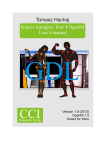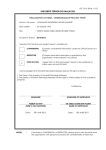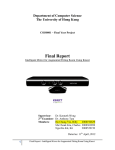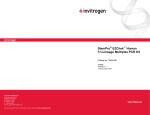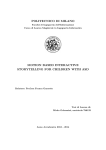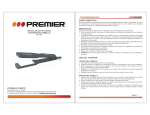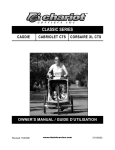Download 1 - Cryptography and Cognitive Informatics Research Group
Transcript
Gesture Description Language Studio v1.05 Author: Tomasz Hachaj, PhD Title: Gesture Description Language Studio v1.05 User's Manual and License Version 1.05 (2014) Kinect for Xbox / Windows CCI Research Group Affiliation: The Laboratory of Cryptography and Cognitive Informatics Pedagogical University of Krakow, 2 Podchorazych Ave, 30-084 Krakow, Poland [email protected] http://www.youtube.com/ccilaboratory http://www.cci.up.krakow.pl/ http://www.cci.up.krakow.pl/gdl/ Kraków, 2014 1 Tomasz Hachaj, CCI Research Group Table of Contents INTRODUCTION ...................................................................................................................... 3 REQUIREMENTS AND INSTALLATION ............................................................................. 4 ACRONYMS LIST .................................................................................................................... 4 INTERFACE .............................................................................................................................. 5 A SELECT DEVICE WINDOW ........................................................................................... 5 B MAIN WINDOW ............................................................................................................... 6 C RECORDER AND PLAYER WINDOW .......................................................................... 8 GDL CLASSIFIER .................................................................................................................. 10 GDLsl EXAMPLES ................................................................................................................. 11 REFERENCES AND USEFULL LINKS ................................................................................ 13 COPYRIGHT NOTICE ........................................................................................................... 14 2 Gesture Description Language Studio v1.05 INTRODUCTION This application demonstrates cooperation of GDL (Gesture Description Language) with Kinect controller and Mirosoft Kinect SDK. This document describes only this application. Manual for GDL can be found elswhere [1]. Gesture Description Language Studio v1.05 is an application written in C# (Windows Presentation Foundation technology) that gives an access to RGB and depth stream of Kinect for Xbox and Kinect for Windows controller. It also enables user’s body segmentation, body joints tracking, body joints recording and gestures recognition (in real time – online and from recordings – off line). Body joints recordings are stored in text *.skl files that can be easily reused by other applications. The gestures recognition is made with GDL classifier that is described elsewhere [1]. Gesture Description Language Studio v1.05 requires third party software and libraries to be successful installed. The installation process is described in next paragraph. Before you decide to use the application in your project READ THE LICENSE (it is available at the end of this file). Long story short: this application is for scientific/educational purpose only. It cannot be used commercially. If the software is used in other software (noncommercial) products, installations or for research, it must always be cited as "GDL" and a reference to the: Tomasz Hachaj, Marek R. Ogiela, Rule-based approach to recognizing human body poses and gestures in real time, Multimedia Systems, February 2014, Volume 20, Issue 1, pp 81-99 has to be given. This form of citation does not require any permission. This software has been tested by many our students but IN NO EVENT SHALL THE COPYRIGHT HOLDER OR CONTRIBUTORS BE LIABLE FOR ANY DIRECT, INDIRECT, INCIDENTAL, SPECIAL, EXEMPLARY, OR CONSEQUENTIAL DAMAGES etc. If you have some questions about application itself, GDL methodology, licensing, scientific and commercial cooperation etc. feel free to contact my e-mail address [email protected]. Good luck and have fun! Tomasz Hachaj 3 Tomasz Hachaj, CCI Research Group REQUIREMENTS AND INSTALLATION Requirements: - OS Windows 7 Home Premium, Service Pack 1, - Processor 3.4 GHZ Intel® Core™ i5-2320 CPU, 3.00 GHz (or similar), - System 64bit, - Memory RAM 4 GB, - Microsoft Kinect for Xbox 360 or Kinect for Windows, - Microsoft .Net Framework 4.0, - Microsoft Kinect for Windows SDK v1.7 or v1.8. To run the application copy files “Gesture Description Language Studio v1.05.exe” and “alut.tif” to the same folder and run exe file. Any further installation of Gesture Description Language Studio v1.05 is not required. ACRONYMS LIST GDL – gesture description language technology GDLsl or GDLs – gesture script language – a formal grammar that is used for definition of GDL rules. Kinect –Xbox 360® Kinect™ Sensor or Kinect™ for Windows Sensor. Application - Gesture Description Language Studio v1.05. Skl – skeleton file format that contains captured skeleton stream data. Skl files are text files but the specification of that data format is currently not open. CCI - The Laboratory of Cryptography and Cognitive Informatics of Pedagogical University of Krakow. 4 Gesture Description Language Studio v1.05 INTERFACE The application is consisted of several windows. A SELECT DEVICE WINDOW After running the application a Select Kinect Device window appears. You have to pick from list one of the positions and click Connect button. All Kinects that are connected to computer are listed as Kinect no. 0, Kinect no. 1 etc. You can connect only to one device. Option None means that you will work offline without a data stream attached. In this case you cannot observe live video from devices however you can play skl recordings and make offline GDL recognition of skl data. In order to change you selection you have to close it and rerun the application. The application uses RGB and Depth stream. 5 Tomasz Hachaj, CCI Research Group B MAIN WINDOW The Main Window of application is consisted of following components: (1) View from RGB Kinect’s camera. If program is connected to controller, this panel is an output of RGB stream. In top left part of this panel an estimated frame capture speed is displayed measured in frames per seconds (fps). The checkbox below the RGB image enables or disables RGB stream capturing. (2) View from processed IR Kinect’s camera. If program is connected to controller, this panel is an output of depth stream. Images are colored in order to simplify the perception of data. The objects that near are blue, further objects are green, yellow and red (the color pattern in look-up table is in below image). In top left part of this panel an estimated frame capture speed is displayed measured in frames per seconds (fps). The checkbox below the Depth image enables or disables Depth stream capturing. (3) View from Skeleton stream. If program is connected to controller, this panel is an output of Skeleton stream. The skeleton tracking is based on Kinect SDK algorithm and has its features and limitation. In top left part of this panel an estimated frame capture speed is displayed measured in frames per seconds (fps). The checkbox below the Skeleton image enables or disables Skeleton stream capturing. (4) GDL library control panel. Button „Load features and rules” run window in which user chooses GDLsl file to be loaded into memory of the application. If the file contains errors (is not correct GDLsl file) application will returns errors. The error message is an exception of GDL parser 6 Gesture Description Language Studio v1.05 instance. If the application returns no error the file if correctly loaded into memory. From this moment the application begins to classify user’s gestures using his or hers tracking skeleton and GDL classifier. If the new GDLsl file is loaded it overrides the previous file. Button „Show features and rules” displays window in which a parsed GDLsl rules tree is presented. If no GDLsl file is loaded clicking on button has no effect. (5) Device control panel. Combo box element contains three values: - RGB - Depth - None. Choosing one option changes background of (3) in Main Window and background of (2) in Recorder and Player Window. The background might be: view from RGB stream, processed view from Depth stream or black background. Slider steers the position of Kinect sensor tilt (up and down). Button „Apply” approve the changes made with slider. Przycisk Reset tilt powraca do pozycji, w której Kinect filmuje równolegle do jego podstawy. Check box „Seated mode” enables or disables Kinect SDK seated mode. 7 Tomasz Hachaj, CCI Research Group C RECORDER AND PLAYER WINDOW (1) Output of GDL classification results. If the GDLsl file was successfully loaded in this area conclusions of the rules names that are satisfied will be displayed. The conclusions will be presented one below another and it is possible that not everyone will be fitted into screen. If in the particular moment no skl recording is played the GDL reasoning is performed online basing on current skeleton stream. If the skl recording is played the GDL reasoning is performed offline basing on skeleton stream from recording. (2) Panel that displays a skeleton. If no recording is loaded in this window the current skeleton tracking data is displayed. If skl recording is loaded the panel presents skeleton from recording. Double-click with left mouse button maximize this window or if it is already maximize returns it to original size. In order to move the window click and hold left mouse button and change the position of window by dragging it. (3) Slider is use to navigate the skl recording. Button “Record” begins the capturing of current skeleton stream into new skl file. The new recording replace old recording in application however it creates new file with unique name on disk that does not override any existing file. Button “Play” plays the skl recording that is currently in memory. Button “Pause” is not supported. 8 Gesture Description Language Studio v1.05 Button “Stop” stops the recording and saves the captured data to disk into folder where application exe file is localized. This button is also used to stop playing of skl recording. Button “Skeleton file” opens the window in which user can choose the skl file to load. Button „Reset recording” removes from application memory skl recording. Check box “S. subrules” if it is checked in GDL output (1) all satisfied conclusions’ names are displayed. If it is unchecked only those conclusions’ are displayed that contains exclamation in their names. 9 Tomasz Hachaj, CCI Research Group GDL CLASSIFIER The GDL classifier’s technology has been described in our paper: Tomasz Hachaj, Marek R. Ogiela, Rule-based approach to recognizing human body poses and gestures in real time, Multimedia Systems, February 2014, Volume 20, Issue 1, pp 81-99 In GDL implementation that we are using in Gesture Description Language Studio v1.05 the following changes has been made: The “old” (NITE/OpenNI – like) body joint set: BodyParts={Head, Neck, LeftShoulder, RightShoulder, Torso, LeftElbow, LeftHand, RightElbow, RightHand, LeftHip, RightHip,LeftKnee, RightKnee, LeftFoot, RightFoot} + {.x|.y|.z} + {[} BodyParts3D={Head, Neck, LeftShoulder, RightShoulder, Torso, LeftElbow, LeftHand, RightElbow, RightHand, LeftHip, RightHip,LeftKnee, RightKnee, LeftFoot, RightFoot} + {.xyz[} Has been replaced by “new” (Kinect SDK - like) body joint set: BodyParts={HipCenter, Spine, ShoulderCenter, Head, ShoulderLeft, ElbowLeft, WristLeft, HandLeft, ShoulderRight, ElbowRight, WristRight, HandRight, HipLeft, KneeLeft, AnkleLeft, FootLeft, HipRight, KneeRight, AnkleRight, FootRight} + {.x|.y|.z} + {[} BodyParts={HipCenter, Spine, ShoulderCenter, Head, ShoulderLeft, ElbowLeft, WristLeft, HandLeft, ShoulderRight, ElbowRight, WristRight, HandRight, HipLeft, KneeLeft, AnkleLeft, FootLeft, HipRight, KneeRight, AnkleRight, FootRight} + {.xyz[} have to be replaced by “new” one. In case when GDL script language data parsing is unsuccessful the application returns error message that is an exception of GDL parser instance. In this message the approximate cause of the error is indicated (it is not complete information about the line and position of error). 10 Gesture Description Language Studio v1.05 GDLsl EXAMPLES I added to application one example GDLsl file and one skl recording. You can load Example.gdl and play Example.skl for the gestures demonstration. I recommend to disable “S. subrules” option (in Recorder and Player window) to see only conclusions of main rules. You can change and redistributed Example.gdl and Example.skl files without any limitation. PSI - is a static gesture, that is demonstrated in above figure. In example file I did two definitions of this gesture: insensitive to user rotation (PsiInsensitive!) and sensitive to rotation (Psi!). Waving (Waving!) - is waving with right hand, the right hand joint should be more or less at the same distance to Kinect as head joint. Select – hold your right hand for four seconds without movement at least 20 cm in front of body. Then to disable select, move your hand closer to the body. Drag (Drag!) – when select is satisfied you can move your hand. Zoom in (ZoomIn!) – put both your hands in front of your body (at least 20 cm) and spread them. Zoom out (ZoomOut!) – put both your hands in front of your body (at least 20 cm) and shrink distance between them. 11 Tomasz Hachaj, CCI Research Group COMMERCIAL LICENCES, SOURCES, FUTHURE PLANS It is possible to obtain commercial license for Gesture Description Language Studio v1.05 and stand-alone GDL classifier library for Kinect SDK. In order to do so please contact me by e-mail: [email protected]. The sources of this application has been obfuscated to prevent (or make more difficult) reverse engineering of it. However we are planning to open the source of Gesture Description Language Studio v1.05 in few months so stay in tuned ;-) The technology is continuously developed and we are testing and producing improvements of both Gesture Description Language Studio and GDL classifier itself. If you are interested in our solutions… stay in tuned… and read our papers! ;-) 12 Gesture Description Language Studio v1.05 REFERENCES AND USEFULL LINKS [1] Tomasz Hachaj, Marek R. Ogiela, Rule-based approach to recognizing human body poses and gestures in real time, Multimedia Systems, February 2014, Volume 20, Issue 1, pp 81-99 [2] Tomasz Hachaj, Marek R. Ogiela, Nowadays and future computer application in medicine, IT CoNvergence PRActice (INPRA), volume: 1, number: 1, 2013, pp. 13-27 [3] Tomasz Hachaj, Marek R. Ogiela, Semantic Description and Recognition of Human Body Poses and Movement Sequences with Gesture Description Language, Computer Applications for Bio-technology, Multimedia, and Ubiquitous City Communications in Computer and Information Science 2012, pp 1-8 [4] Tomasz Hachaj, Marek R. Ogiela, Computer Karate Trainer in Tasks of Personal and Homeland Security Defense, A. Cuzzocrea et al. (Eds.): CD-ARES 2013 Workshops, LNCS 8128, pp. 430–441, 2013 [5] Tomasz Hachaj, Marek R. Ogiela, Marcin Piekarczyk, Dependence of Kinect sensors number and position on gestures recognition with Gesture Description Language semantic classifier, Preprints of the Federated Conference on Computer Science and Information Systems (2013), pp. 575–579 [6] Tomasz Hachaj, Marek R. Ogiela, Marcin Piekarczyk, Real-Time Recognition of Selected Karate Techniques Using GDL Approach, Image Processing and Communications Challenges 5, Advances in Intelligent Systems and Computing Volume 233, 2014, pp 99-106 [7] Official Kinect for Windows website http://www.microsoft.com/enus/kinectforwindows/ [8] Drivers for Kinect SDK (installation of those drivers are required!) http://www.microsoft.com/en-us/kinectforwindowsdev/Downloads.aspx [9] The Laboratory of Cryptography and Cognitive Informatics official website http://www.cci.up.krakow.pl/ [10] GDL project official website http://www.cci.up.krakow.pl/gdl/ 13 Tomasz Hachaj, CCI Research Group COPYRIGHT NOTICE Copyright (c) 2014 Tomasz Hachaj, The Laboratory of Cryptography and Cognitive Informatics [email protected] http://www.cci.up.krakow.pl/ http://www.cci.up.krakow.pl/gdl All rights reserved. This product includes software developed by Tomasz Hachaj for use in the Gesture Description Language Studio v1.05 application (called later Software). The implementation is based on scientific paper: Tomasz Hachaj, Marek R. Ogiela, Rule-based approach to recognizing human body poses and gestures in real time, Multimedia Systems, February 2014, Volume 20, Issue 1, pp 81-99 Redistribution and use in binary forms, without modification, are permitted provided that the following conditions are met: Redistributions in binary form must reproduce the above copyright notice, this list of conditions and the following disclaimer in the documentation and/or other materials provided with the distribution. Redistributions of source code of Software are forbidden. You may not reverse engineer, decompile, or disassemble the Software. This Software can be used only for scientific or/and educational purpose. It cannot be used commercially. Neither the name of the Software nor the names of its contributors may be used to endorse or promote products derived from this Software without specific prior written permission. If the Software is used in other software products, installations or for research, it must always be cited as "GDL" and a reference to the: Tomasz Hachaj, Marek R. Ogiela, Rule-based approach to recognizing human body poses and gestures in real time, Multimedia Systems, February 2014, Volume 20, Issue 1, pp 81-99 has to be given. This form of citation does not require any permission. THIS SOFTWARE IS PROVIDED BY THE COPYRIGHT HOLDERS AND CONTRIBUTORS "AS IS" AND ANY EXPRESS OR IMPLIED WARRANTIES, INCLUDING, BUT NOT LIMITED TO, THE IMPLIED WARRANTIES OF MERCHANTABILITY AND FITNESS FOR A PARTICULAR PURPOSE ARE DISCLAIMED. IN NO EVENT SHALL THE COPYRIGHT HOLDER OR CONTRIBUTORS BE LIABLE FOR ANY DIRECT, INDIRECT, INCIDENTAL, SPECIAL, EXEMPLARY, OR CONSEQUENTIAL DAMAGES (INCLUDING, BUT NOT LIMITED TO, PROCUREMENT OF SUBSTITUTE GOODS OR SERVICES; LOSS OF USE, DATA, OR PROFITS; OR BUSINESS INTERRUPTION) HOWEVER CAUSED AND ON ANY THEORY OF LIABILITY, WHETHER IN CONTRACT, STRICT 14 Gesture Description Language Studio v1.05 LIABILITY, OR TORT (INCLUDING NEGLIGENCE OR OTHERWISE) ARISING IN ANY WAY OUT OF THE USE OF THIS SOFTWARE, EVEN IF ADVISED OF THE POSSIBILITY OF SUCH DAMAGE. 15
















